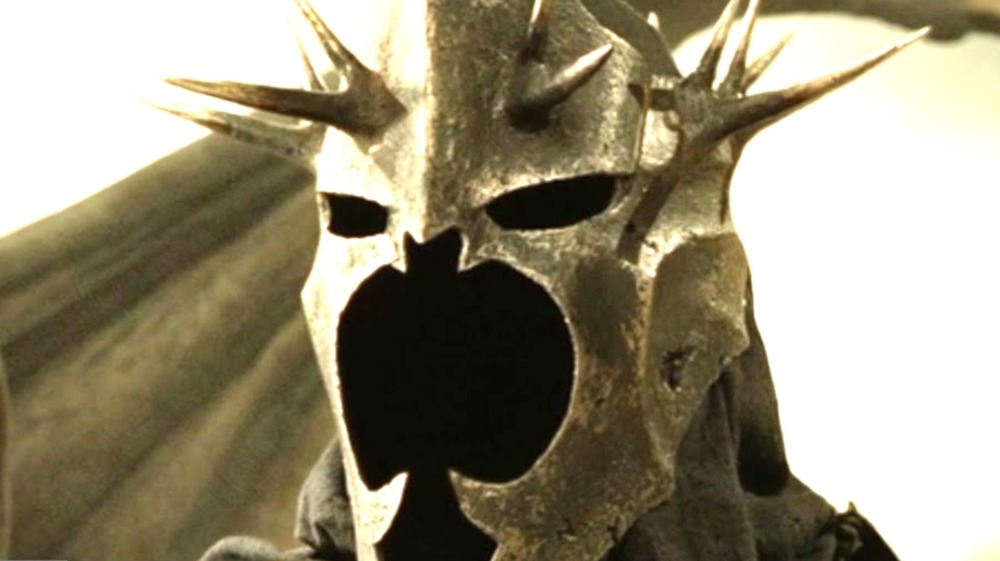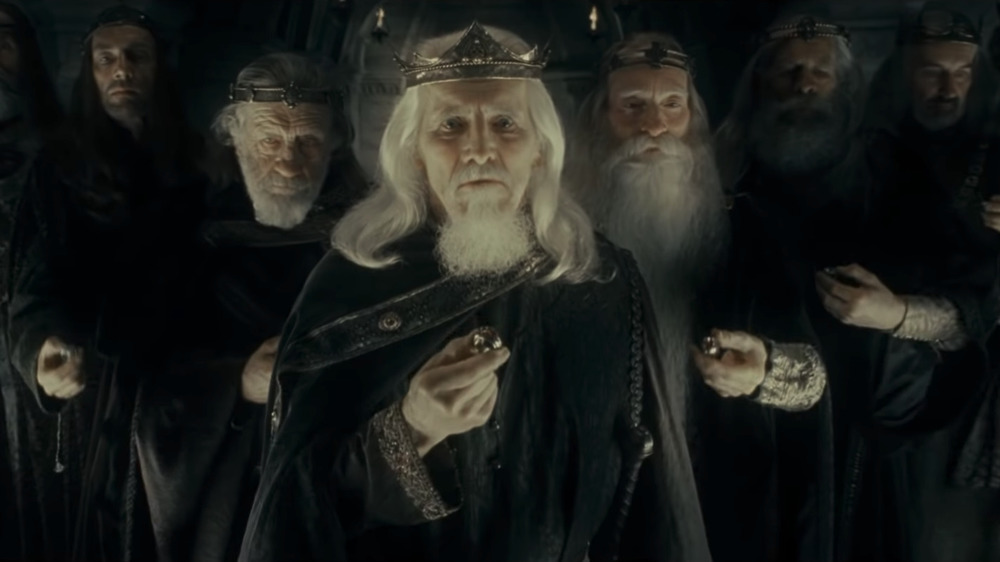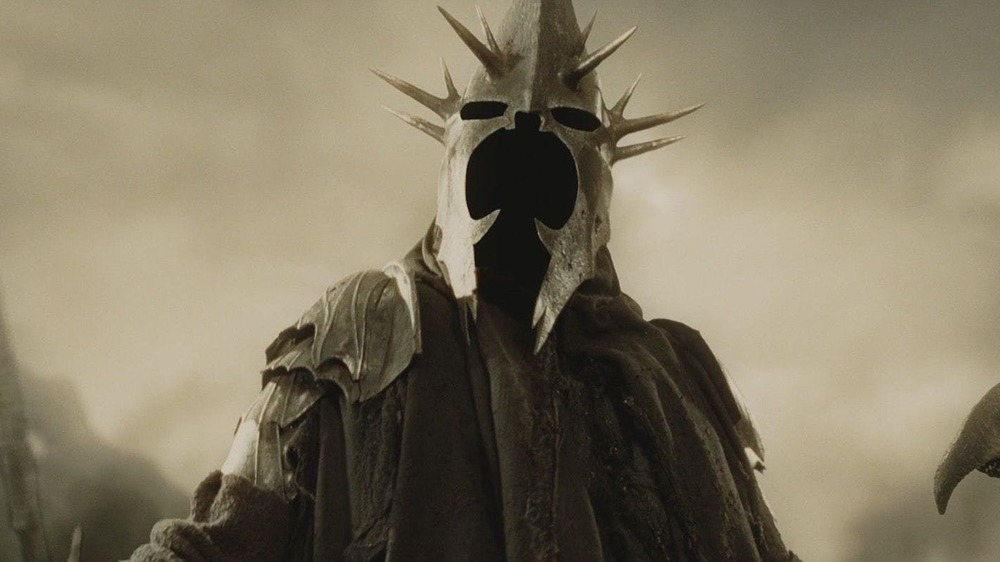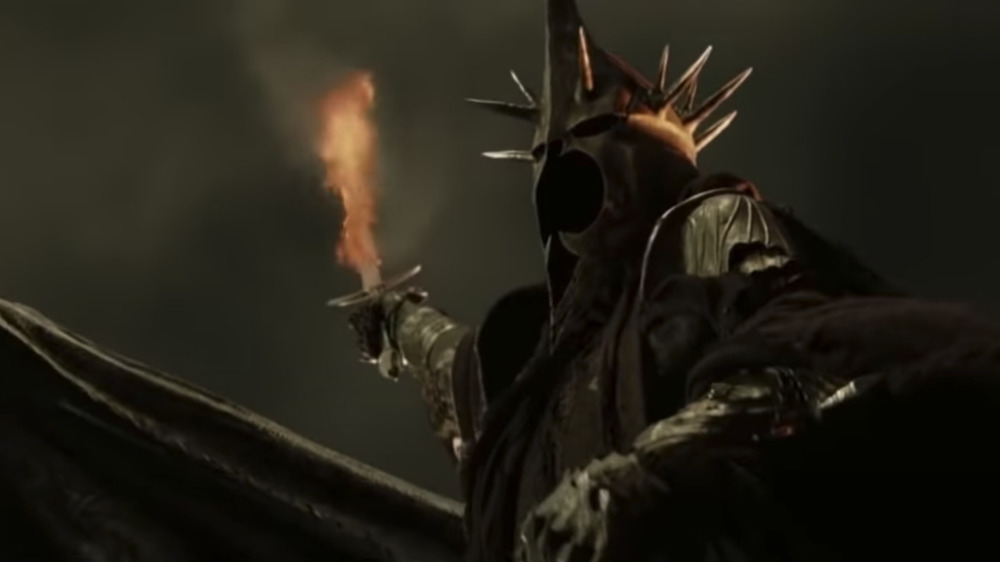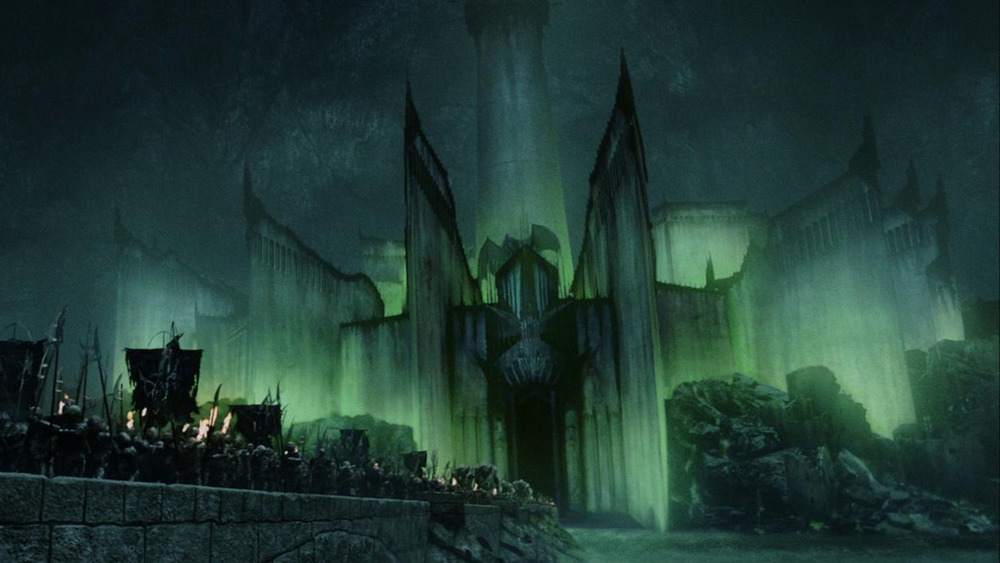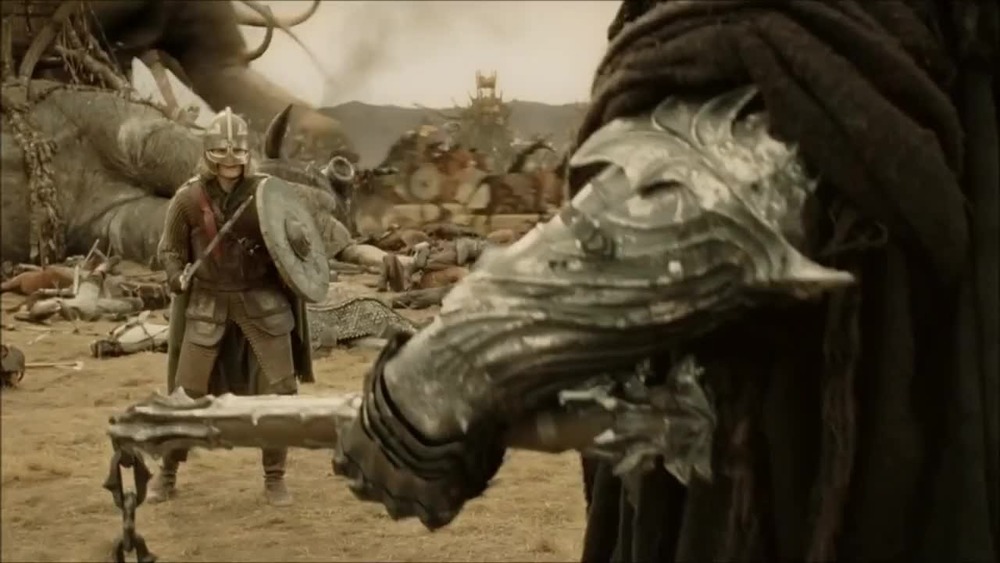The Witch-King Of Angmar's Backstory Explained
When people talk about Lord of the Rings villains, they're usually referring to Sauron. And no wonder, too. The story is literally named after him. When Sauron isn't the baddie in question, the conversation is usually aimed at the traitor Saruman. For all the pair's grandiose drama, though, there's another devilish knave who never seems to quite get his due.
The Witch-king of Angmar is an enormously important person in J.R.R. Tolkien's works. The Black Captain wields a Ring of Power, heads up the Black Riders, leads Sauron's armies in battle, and is generally at the front of the action wherever and whenever it takes place. In Peter Jackson's film adaptations, it's even hinted that the Witch-king could be stronger than Gandalf himself — a notion that fans of the original source material will quickly dispel. Nevertheless, there's no doubt that the Witch-king of Angmar is an overpowered villain who dominates the dark side of the Lord of the Rings story.
The thing is, for all of his involvement, the dude doesn't really get much of a backstory. At least not in the main LotR trilogy. Sure, the Witch-king is a great villain, but we live in an age where the "enemy" is never simply a one-dimensional character with no background or personal interests. So, where does this fearful servant come from? How did he become a wraith? What is it that motivates him? Why is he in charge of the other Nazgûl? And where the heck is "Angmar?" Let's break it down, shall we?
Origins and early history
The Witch-king's story first picks up when Sauron captures the Rings of Power in the middle of the Second Age (thousands of years before The Lord of the Rings' story) and distributes nine of them to Men. In The Silmarillion, it says that three of these "were great lords of Númenórean race." This is the same nation of individuals that eventually founds Gondor, and whose rulers are also Aragorn's royal ancestors. While it's never made clear, it's guessed that the Witch-king is one of these three Númenórean lords.
His Ring of Power extends the life of the Ringwraith, helping him gain glory and wealth in the process. However, these come at a cost. Over the centuries he and his eight companions slowly slip into a strange ghostly state of existence from which they serve their otherworldly master, Sauron.
The Nazgûl first appear on the scene over two thousand years into the Second Age. The period is über epic — filled with violence and melodrama. It's also the Age in which Amazon Studios is setting its forthcoming Tolkien show. During this era, Sauron is at his peak power, and it's fairly safe to assume that the Witch-king has a grand old time imposing his master's will across the continent. Nevertheless, we don't hear much specifically about the Witch-king or his dreadful companions for the rest of the Second Age.
The age ends when Sauron is defeated by the Last Alliance. This is the thrilling event briefly depicted in the opening moments of The Fellowship of the Ring film. When the One Ring is cut from Sauron's finger, he is temporarily defeated, and his servants — including the Witch-king — disappear from the history books for a long time. It isn't until more than a millennium into the Third Age that we start to see activity again.
Resurgence
At this point, the Witch-king's résumé isn't much to write home about. The dude is basically a corrupt Númenórean nobleman who is given a Ring of Power, becomes a wraith, and then leads some sort of mysterious life as "the Dark Lord's most powerful servant." Needless to say, the details are seriously lacking. Fortunately, when you're working with what amounts to artificial immortality, a rap sheet can stretch on for thousands of years before the action really picks up — which, by the way, it's about to.
See, Sauron begins to rebuild his power roughly a thousand years into the Third Age. He starts by setting up a new base of operations in Mirkwood. The Witch-king is probably around at this point, but he isn't specifically associated with his master's new activity for nearly three more centuries — again, that darned immortality slowing down the timeline again.
In the appendix to The Return of the King, it says that around 1300 years into the age, "The Nazgûl reappear." This chilling notification is followed by the line "The chief of these comes north to Angmar." Translation: The Lord of the Nazgûl heads to the northwestern region of Middle-earth and sets up a new kingdom. His objective? The destruction of Gondor's northern sister nation, the splintered and struggling kingdom of Arnor. By this time, Arnor had split into three separate kingdoms and looked ripe for the picking. The Ringwraith begins calling all sorts of evil creatures to his new realm, and before long he starts attacking his divided foes.
The King of Angmar
It's here in his fancy new kingdom in the north, that the Lord of the Nazgûl officially picks up his nickname of the "Witch-king." After a century of initial troublemaking, the Witch-king of Angmar attacks the northern realm with a large army. He nearly destroys all three realms. However, the attack is stopped and driven back when the local Men are aided by Elvish warriors from the Grey Havens, Rivendell, and Lothlorien. As an interesting side note, it's during this fighting that the tower on Weathertop — where Frodo is later stabbed — is destroyed.
At this point, the region goes into a sort of running conflict where neither side can quite get the upper hand. In typical Tolkienian style, the fight drags on ... for 500 years. Then, nearly 2000 years into the Third Age, the Witch-king finally defeats the northern kingdom. However, his victory is short-lived, as just one year later, a huge army arrives from Gondor. Joining with the local Elves — and even some Hobbit archers, to boot — they crush the forces of Angmar once and for all.
Even in defeat, the Witch-king refuses to go down without a fight, though. Before he high-tails it out of the disaster, he uses his otherworldly horror to spook the horse of Eärnur, the leader of the Gondorian relief forces. When the embarrassed warrior gets control of his mount, he prepares to chase after the then fleeing Witch-king. At that point, the Elf Glorfindel stops him, stating thatm "far off yet is his doom, and not by the hand of man will he fall."
These prescient words are remembered for a very long time.
A not-so-kingly duel
Five years after his defeat in the north, the Witch-king arrives in Mordor and gathers his fellow Ringwraiths to him. They gather new strength and, twenty years later, attack the nearby Gondorian city of Minas Ithil. They capture it and rename it Minas Morgul. This is the same ghastly city that Frodo, Sam, and Gollum pass by on their way up the mountain pass to Shelob's lair.
As another interesting side note, in claiming their new home, they also capture one of the seeing stones known as the palantír. This is the same one that Sauron later uses to communicate with Saruman, Denethor, and Aragorn.
With a new home base, the Witch-king regains some of his swagger. A few decades later, he challenges the king of Gondor to a duel. He taunts the monarch — who happens to be the same fellow whose horse he spooked in battle in the north. The headstrong king is initially convinced to refuse the temptation. However, when the Witch-king renews the mocking threat several years later, the ruler rides to Minas Morgul to defend his honor. Except, yeah, it's a trap, and the king is never seen again.
In fact, this is the event that leaves Gondor without a king. The stewards of the realm take over leadership "until the king returns" and end up ruling for the next millennium, at which point a ranger by the name of Aragorn finally takes up the kingship again. In the meantime, the Witch-king and his Ringwraith brethren enter another senescent period.
Prophecy fulfilled
Over the last millennium of the Third Age, the Witch-king doesn't get too tangled up in the action. He causes some trouble for Gondor at times. His armies even start the fighting that ends up destroying the city of Osgiliath — the same ruined metropolis that the orcs cross in boats when they attack Minas Tirith in The Return of the King. Still, overall, once his glory days in Angmar are through, the Witch-king doesn't directly see much action until the War of the Ring rolls around.
Then, as the Third Age winds down, the Witch-king leads the nine Black Riders out of Mordor on a great hunt for the One Ring. While they fail, they come very close to catching Frodo and his companions as they flee from the Shire, connect with Aragorn, and barely make it to Rivendell. When the ghastly crew loses their horses and black robes in a flood outside of Rivendell, they slowly make their bodiless ways back to Mordor. Once they get back, they're fitted out with new clothes, and their horses are replaced by terrifying flying beasts.
From there, the Witch-king helps his master prepare for a long-planned assault on a now weak and failing Gondor. In The Two Towers and The Return of the King, he leads that attack, which culminates with the Battle of the Pelennor Fields. There, on the plains before the capital of Gondor, the Black Captain finally meets his long-prophesized doom, falling at the hands of a Hobbit and a woman. It's a fitting end to a dramatic life, overextended by a magic ring, committed to slavish servitude to his Dark Master, and spent as a perpetual thorn in the side of the Free Peoples of Middle-earth.
